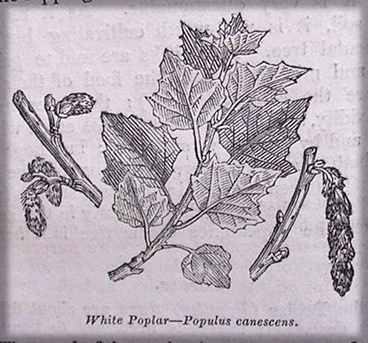
Properties of Timber - Poplar
There are about fifteen species of poplar (Populus) but it is only necessary to mention two as timber trees; the white (or spreading) poplar (Populus canescens) and the Lombardy poplar (Populus dilatata), which is spire-shaped, has its branches at very small angles with the trunk, and runs up to a great height. The abele tree, Populus Alba, is distinguished by its broad leaves. All the poplars are fond of moisture, and may be planted near marshy places, where few other trees, save the alder, will grow.
The small-leaved white poplar is a native of most parts of Europe, but it is doubtful whether the large-leaved abele poplar, is a native of England. The plants of it were obtained mainly from Flanders in the seventeenth century.
The poplar grows very rapidly. In favourable situations it will make shoots three inches in diameter, sixteen feet long, in the course of a single season. The loppings of the poplar burn slowly, and thus they are superior to Elm and many other trees for the heating of ovens.
Poplar wood is soft, and far from durable, but it is not apt to swell or shrink, or to warp, and it is very light, so it is used to make butchers' trays, hogs' troughs and other articles in which lightness and cheapness are preferred to durability.
It is a tree largely cultivated by the Dutch, being well adapted to their soil and climate.
On the continent a species of poplar is cut into thin slices called sparterie, which is made up into ladies' bonnets. The seeds of the white poplar are also surrounded by a sort of white cotton. There have been attempts to use this to manufacture paper and even cloth. Pallas, in his voyages, tried to show that the cotton of Populus Alba was as valuable as that of America, but no experiments on it have been successful.
In Holland, the black poplar is much cultivated. It grows rapidly, is cut down at about twenty-four years old, and made into wooden shoes and other articles. The timber is of nearly the same quality as white poplar, perhaps a little better, and is used for the same purposes.
The trembling poplar, or aspen, is unusual. Its leaves are caused to tremble by the slightest breeze. Its timber is about the same as white poplar and used for the same things.
The leaves of the poplars are mostly of a pale or silver colour on the underside, and the twigs are flexible. The motion of poplar in the wind is peculiarly graceful.
The Lombardy poplar grows rapidly, and shoots in a compact spire to a great height. It is not so hardy as the others but when planted in favourable soil will grow four or five feet per year.
The timber of the Lombardy poplar is even worse than that of the other poplars, but for temporary purposes the rapidity of its growth is some compensation. It is perhaps the lightest of timber, and used for packing cases. Though soft, it will bear some strain without breaking. The vessels in which the people of Lombardy carry and squeeze their grapes are all made of this wood, and they frequently train their vines to it. In England it is chiefly used as an ornamental tree. The Lombardy poplar is the only spiry tree which is deciduous. It has a shape similar to the cypress, though its leaves are different.

summarised from "The Library of Entertaining Knowledge - Timber trees" (1829), pub. Charles Knight, Pall Mall.
ND, habitat21
big turbines
small turbines